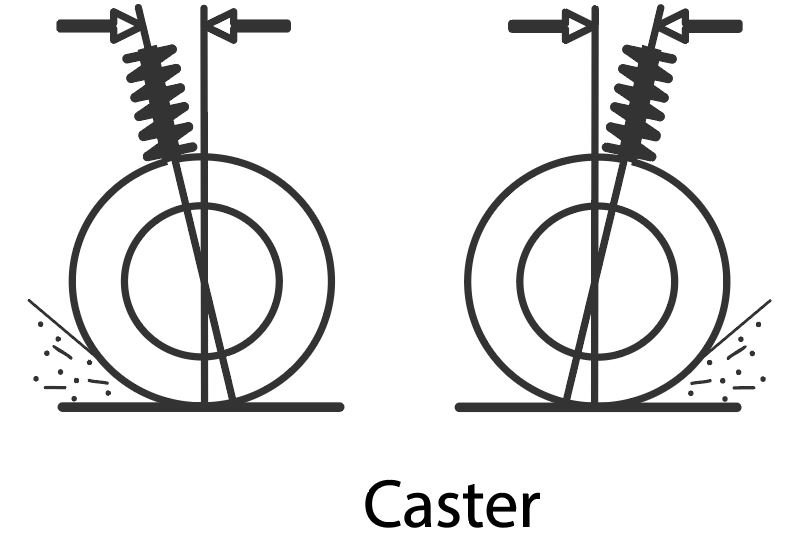Wheels Off Track? How to Spot the Signs of a Bad Alignment
Get ready to buckle up and navigate the twists and turns of wheel alignment! In this guide, we’re going to unveil the secrets behind spotting the signs of a bad alignment. Whether you’re a seasoned driver or new to the road, understanding wheel alignment and its impact on your vehicle’s performance is crucial. It’s time to take control and ensure your ride is smooth, safe, and aligned to perfection. Let’s hit the road!
Understanding Wheel Alignment: The Basics
When it comes to proper vehicle handling and maximizing tire wear, wheel alignment takes center stage. So, what exactly is wheel alignment? It refers to the precise adjustment of the angles at which your wheels make contact with the road. This adjustment ensures that all four wheels are parallel to each other and perpendicular to the ground.
To achieve this alignment, three key components come into play: camber, toe, and caster. Camber refers to the vertical tilt of the wheels, while toe relates to the angle at which the tires point inward or outward. Caster, on the other hand, concerns the forward or backward positioning of the steering axis. These components work in harmony to ensure proper weight distribution, stable steering, and optimal tire contact with the road.



The Benefits Of A Proper Alignment
Maintaining a good wheel alignment offers a multitude of benefits that go beyond just smooth handling. Firstly, it contributes to improved fuel efficiency, as aligned wheels reduce rolling resistance and minimize unnecessary drag. Secondly, it extends tire longevity by promoting even tread wear and preventing premature tire deterioration. Lastly, a well-aligned vehicle enhances overall performance, providing a more comfortable and enjoyable driving experience.
How to Identify the Red Flags
As you hit the road, it’s crucial to keep an eye out for signs that your wheels may be out of alignment. These indicators can help you identify potential alignment issues before they escalate into more significant problems. Keep an eye out for:
- Uneven or Excessive Tire Wear: Misaligned wheels can cause uneven tire wear patterns, with one side of the tire wearing down faster than the other. This can appear as feathering, cupping, or bald spots on the tire tread.
- Pulling to One Side: If your vehicle tends to drift or pull to one side without any input from you, it could be a clear sign of wheel misalignment. The vehicle’s tendency to veer off course indicates that the wheels are not aligned parallel to each other.
- Vibrating Steering Wheel: A vibrating or shaky steering wheel, especially at higher speeds, can be an indication of wheel alignment issues. Misaligned wheels can cause the steering wheel to vibrate or shake due to inconsistent tire contact with the road surface.
- Crooked Steering Wheel: Take a quick glance at your steering wheel while driving on a straight, level road. If you notice that the steering wheel is off-center or tilted to one side, it could be a result of misaligned wheels.
These signs of bad wheel alignment can stem from various causes, such as hitting potholes or curbs, driving over rough terrain, or simply wear and tear over time. Misaligned wheels can lead to an array of issues beyond the obvious steering and tire problems. They can put additional strain on suspension components, affect the vehicle’s overall stability and handling, and even impact fuel efficiency.
Maintain That Alignment!
Now that we’ve unmasked the mysteries of wheel alignment, let’s dive into some savvy tips and maintenance practices to keep your wheels on the straight and narrow. Here’s the lowdown on maintaining a proper wheel alignment:
- Frequency of Wheel Alignments: Regular wheel alignments are critical. It’s recommended to schedule an alignment check every 10,000KM or as advised by your vehicle’s manufacturer. However, keep in mind that certain factors, like encounters with potholes, curbs, or the general wear and tear of everyday driving, may warrant more frequent visits to the alignment shop.
- Proactive Measures: Start by regularly rotating your tires to ensure even wear and tear. Check your tire pressure regularly too because underinflated or overinflated tires can throw your alignment off balance. And hey, we know it’s tempting, but try to avoid those rough road conditions whenever possible – your wheels will thank you for the smoother ride.
Remember, a well-aligned vehicle not only improves your driving experience but also saves you from potential headaches down the road. So, stay aligned, and let’s enjoy a smooth ride together!

